Iceland in Summer: Your Complete Guide
August 5, 2022
Iceland in Summer: Your Complete Guide
August 5, 2022
Sunshine, long evenings, and sumptuous green landscapes make Iceland in summer a glorious place to be. It’s the time when temperatures rise, snows melt, and you can explore Iceland’s outdoors in all their majesty.
In this blog post, we share some of the best things to do in summer in Iceland—and we’ll give you some top tips for your visit too.
At Reykjavik Excursions, we have a wide selection of summer tours and activities in Iceland. Book today and experience Iceland’s summer for yourself.
When is summer in Iceland?
As in the rest of the northern hemisphere, summer in Iceland is between June and early September. These are the warmest months in the Icelandic calendar, and they’re also the most popular months for visitors to the country.
Long ago, when Iceland used the Old Norse calendar, the country had just two seasons—summer and winter—both lasting six months. That’s why, still today, Icelanders celebrate a national holiday on the first Thursday after the 18 April, when summer officially begins.
Of course, while we call this summer, the temperatures might disagree. Snow often still falls in the months of April and May. In fact, there are only four months in the year—the summer months of June, July, August, and September—when there’s really no snowfall at all.
What’s it like in Iceland in the summer?
Iceland in the summer enjoys long bright evenings and more stable weather. It’s the most popular time to visit Iceland for good reason. The sun shines and the green shades of nature frame the white snowy tips of the hills.
Summer is also the time when the vast majority of Iceland tours are available. Often in winter trips to Iceland’s Highlands are difficult, for example, with snow-blocked roads and shortened days. But in summer it’s all open.
That’s why in summer Icelanders pack their tents and head to the hills to camp or to enjoy a music festival. Across the country there are many outdoor events that help locals and visitors make the most of the summer.
Of course, we need to say a word or two about the famed midnight sun. Due to Iceland’s latitude, the country has very long summer days.
In fact, at their longest, the sun hardly drops below the horizon at all. On 21 June, Summer Solstice, the sun rises in Reykjavik at 02:49 and sets again at 00:06. That means that days last for over 21 hours (and there’s no total darkness at all)—giving you plenty of time to explore all of Iceland’s summer wonders.
How warm is Iceland in the summer?
Summer is when Iceland is at its warmest. Temperatures are mild and the weather is less volatile than in the winter.
What is the average temperature in Iceland in the summer? In the capital city of Reykjavik, average high temperatures are around 14-15°C (57-59°F) throughout June, July, and August, and they typically reach lows of 7-8°C (44-46°F) in the evening.
Of course, they can get higher than this—Reykjavik’s record July temperature is 25.7°C (78.3°F)—but this doesn’t happen very often.
Outside of the city, and particularly in the Highlands, temperatures are typically cooler. However, the record temperature ever recorded in the country—a scorching 30.5°C (86.9°F)—was in eastern Iceland nearly a hundred years ago.
How much does it rain in Iceland in the summer?
The Iceland summer may be warmer, but don’t expect it to be completely dry.
Throughout June to August, expect about 55mm (2.2 inches) of rain each month, with rain falling 10 days of each month on average. So, while it can be rainy, it’s not all bad. For reference, in England, average rainfall is over 65mm (2.5 inches) throughout the same months!
So, while it could be worse, it’s definitely wise to pack a jacket.
Can you see the northern lights in Iceland in summer?
Unfortunately, no, you cannot see the northern lights in Iceland in the summer. That’s because there’s just too much light in the sky.
During the summer months, tour operators typically pause their northern lights tours and wait for the northern lights season, which runs throughout the winter. This is when the nights are long and when the gorgeous colours of the aurora borealis are visible against the dark sky.
While this time you won’t be able to see them, we invite you back to Iceland in winter, when you can glimpse this awesome display for yourself. However, on your summer trip, there’s still plenty for you to get up to.
What to do in Iceland in summer?
So what does summer in Iceland have to offer? From wildlife watching to Highland adventures, you’ll be spoiled for choice.
Go whale-watching on a wildlife tour
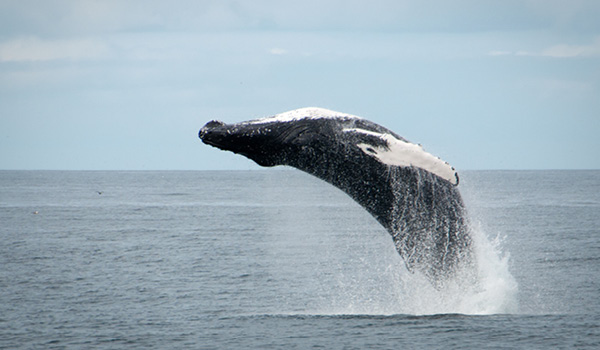
Summer is when wildlife returns to Iceland. Migratory birds including oystercatchers, teal, and great skua return to Iceland, while the seas are rich with marine life too.
Whales are one of the main draws for summer visitors. Iceland’s waters host as many as 12 different species of whale, including humpbacks, minke whales, sperm whales, and even blue whales. By some accounts, it’s simply the best place in the world for whale watching tours.
Of course, you won’t only see whales. Dolphins and seals also populate these waters. And throughout the summer, you’ll have the chance to see Iceland’s puffins—which account for up to 60% of the entire Atlantic puffin population. They are a truly special species.
Bathe in hot springs, spas, and lagoons
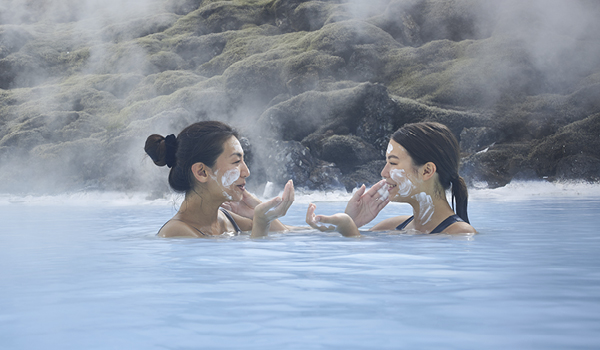
You may have heard of Iceland’s volcanic activity, which in the past has disrupted international air travel, created much of the land of Iceland itself, and even changed the global climate.
Yet Iceland’s geothermal activity is responsible for some of the most calming, rejuvenating, and simply wonderful experiences on the planet too. Without it, tours to hot springs, spas, and pools in Iceland just wouldn’t be possible.
Two of the most luxurious spa experiences are the Blue Lagoon and the Sky Lagoon, two destinations close to Reykjavik that showcase Iceland’s spa culture at its best.
Alternatively, one truly unique experience in Iceland can be had in Reykjadalur Valley. Here, you’ll find natural warm springs—and a warm river—that are ideal for bathing. It’s near Hveragerði on the south coast.
See the midnight sun in Iceland
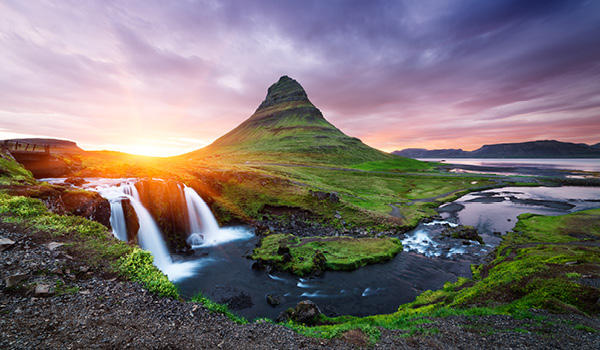
Summer in Iceland might not have the northern lights, but it does have something equally special: the midnight sun. Throughout the summer months, the sun barely falls below the horizon, offering long, bright days and gorgeous light conditions throughout the night.
The summer solstice on 21 June is the best time to experience the midnight sun, as this is when days last longest. Across two weeks around this time, nights don’t get dark at all. Instead, throughout the night, you can experience the golden hues of perpetual dusk.
As perhaps you can imagine, it’s an incredible time for photography. Iceland’s mountains and fjords really show off their beauty. It’s an experience you won’t forget.
Explore the south coast of Iceland
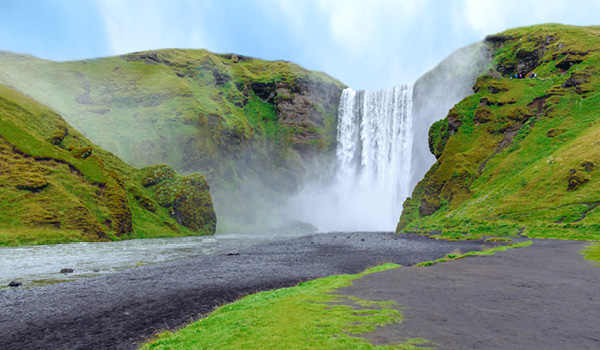
One of the best of Iceland’s regions to explore in the summer is the south coast. Along Iceland’s southern shore, you’ll find the glaciers and lakes, waterfalls and geysers, mountains and beaches that make this country so famous.
For example, experience the Jökulsárlón glacier lagoon, a lake created by the meltwater from the Vatnajokull glacier. In the summer, you can see icebergs float serenely on the icy waters of the lagoon, alongside grey seals and other wildlife.
Close by you’ll also find the magical Diamond Beach in Iceland, where shards of melting ice appear like glistening diamonds on the beach’s black sands.
Alternatively, visit the Reynisfjara black sand beach, one of the most iconic sights on Iceland’s south coast. Just outside of the tranquil fishing village of Vík, you’ll find the beach’s dramatic sea stacks and caves. And, of course, the mysterious black sand for which it is so famous.
No trip to the south coast of Iceland would be complete—in any season—without exploring Iceland’s Golden Circle.
One of the most popular itineraries in the region, it is also one of the most rewarding. The Golden Circle showcases three stupendous sights: the Gullfoss Waterfall, the Geysir Geothermal Park, and Þingvellir National Park.
Discover more in your ultimate guide to the south coast of Iceland. Or book a south shore tour today.
Go hiking in Iceland’s Highlands
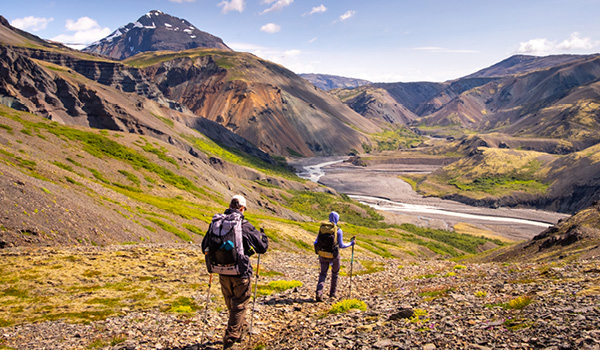
Much less visited than Iceland’s south coast are the Highlands. Covering over 15,000 square miles (39,000 square kilometres), the Highlands are completely uninhabited—and often inaccessible throughout the winter. That makes a summer visit an absolute must.
One of the most popular destinations in Iceland’s Highlands is Þórsmörk, a remote valley surrounded by mountains and glaciers. With exceptional hiking trails and simply wondrous views, it’s definitely worth the drive.
Alternatively, explore the hills and bubbling mud pools of Landmannalaugar, the heart of much of Iceland’s seismic activity. Or take the 34-mile (55km) hiking trail, Laugavegur, across the wilderness. You’ll scale mountains and discover untouched lakes.
Find out more in our guide to Iceland’s Highlands. Or book the Highland Bus for hiking in Iceland.
Visit the glaciers
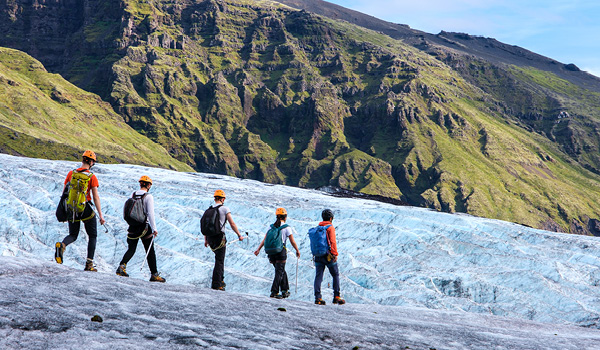
Iceland proudly boasts its nickname, the “land of fire and ice”. And yes, even during Iceland’s summer, there’s plenty of ice to behold. In fact, 11% of the country’s surface area is covered in glacial ice.
That means that there are many opportunities to witness glaciers, these mighty sheets of compressed snow. On a classic tour of the Golden Circle, for example, you won’t miss the majestic sight of the Langjökull, Iceland’s second-largest glacier.
Or you can experience it up close on a snowmobile tour or on a hiking trip across the ice. There really is an option for everyone.
Discover more in our ultimate guide to Iceland’s glaciers or book a glacier tour in Iceland.
Enjoy Iceland’s summer festivals
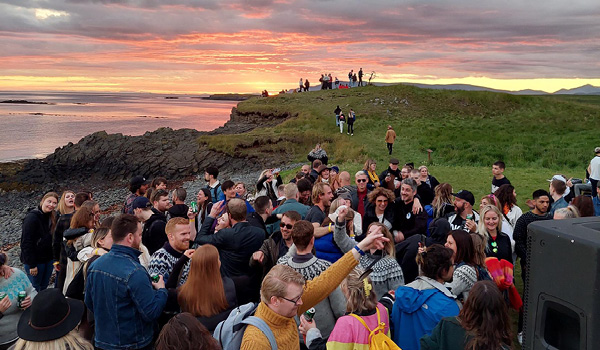
With less than 400,000 inhabitants, Iceland really punches above its weight in terms of its cultural output. And the summer is by far the best time to delve into its festival culture.
Culture Night, or "Menningarnótt", for example takes place in Reykjavík in late August and features live music, art, pop-up shows and all sorts of activities around the downtown area.
Alternatively, among many other festivals, there’s the Siglufjörður Folk Music Festival in July or the Reykjavik Jazz Festival in August.
There are many other big festivals across the country throughout the summer—particularly on the last weekend of July. Þjóðhátíð, for example, happens this weekend, and sees thousands of people gather in Herjólfsdalur valley on the island of Heimaey, for music, camping, and more.
Explore Reykjavik

Iceland’s capital city of Reykjavik is home to a third of the country’s population. While still modest in size for a capital, it’s bustling, diverse, and surprising—with lots to see and do.
Start with some of the city’s unique architecture and design. The Hallgrímskirkja church, for example, is Iceland’s largest church and probably the most recognisable building in Iceland. Meanwhile, Harpa—Iceland’s concert hall—is strikingly modern, inspired by the country’s geology.
While you’re at it, explore Reykjavik’s downtown, including the main streets of Laugavegur and Skólavörðustígur, lined with charming boutiques, cafes, and bars. Visit too the Austurvöllur Square, the site of political gatherings and summer sunbathing alike.
During the summer, follow the locals up to Nauthólsvík, for a bracing summer swim, or visit the Seltjarnarnes Peninsula, a nature reserve and the home of the Grótta lighthouse.
Find out more things to do in Reykjavik or explore one of our Reykjavik city tours.
Travel tips for your Iceland summer trip
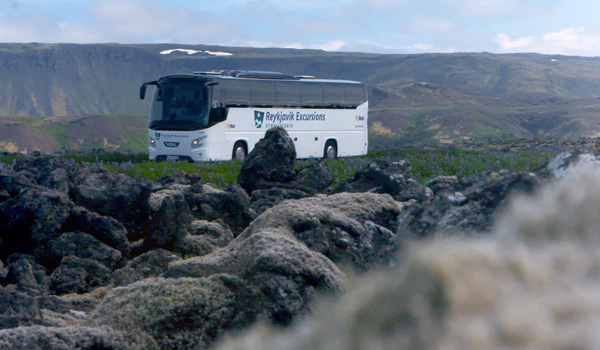
Sublime landscapes and unforgettable experiences await on your summer trip to Iceland. But what practical information do you need to know before you arrive? Here we share some key tips.
Getting around Iceland in summer
While in winter many of Iceland’s roads are closed, summer’s milder temperatures and longer days mean that travel is much easier during this season.
No matter where you want to go or what you want to do in Iceland’s summer, you’ll have three main options for getting around:
• Coach tours. The most popular option for getting from A to B is by coach. Whether you’re interested in a day tour of the Golden Circle or a one-way journey to the Highlands to begin a hike, there’s a coach that can take you there. Check out our tours and activities.
• Tailor-made tours. Maybe you want to plan a unique itinerary or you want to bring some friends on a private group tour. At Reykjavik Excursions we can help you organise tailored tours designed to suit your needs.
• Self-drive tours. Sometimes you can’t beat the freedom of getting into a car and going where your heart takes you. We can help you with car hire too.
What to pack for Iceland summer?
Iceland’s summer is mild and can sometimes be wet. So what should you bring with you? Here are five things you shouldn’t forget to pack.
• Lots of layers. Mild days and cool nights mean that you need to be prepared for all sorts of different temperatures. Dressing in layers is the secret.
• Waterproofs. The chances are that it will rain at least some of the time you’re in Iceland. Pack some decent waterproofs and you’ll stay dry.
• Midge spray. Like much of northern Europe, parts of Iceland can have biting midges during the summer months. Midge repellent such as Smidge can help.
• Sturdy shoes. Whichever sights you’re visiting, you’ll need to do at least a bit of walking. Some strong reliable shoes are best when crossing glaciers or just walking outside of the city.
• Eye mask. Throughout the summer, the hours in which it’s fully dark are limited. An eye mask can help you get to sleep when it’s still light outside.
Visit Iceland in summer with Reykjavik Excursions
Come and experience summer in Iceland for yourself. With its bright nights, mild days, and its gorgeous mix of greenery and glacial scenes, there’s no better time to visit.
At Reykjavik Excursions, we make it our mission to make it as easy as possible to experience Iceland’s summer to the full. We run a variety of tours daily throughout the season, to help you see Iceland’s sights in comfort and style.
But not just in summer. We’ll be there to help whenever you want to visit. Book your tours & activities in Iceland.
Tours in the spotlight
REYKJAVIK EXCURSIONS BLOG
Get inspired! Information and tips and must see places in Iceland, fun facts, customs and more.
The Silver Circle of West Iceland - Your Guide
You’ve heard of the Golden Circle, but here’s why you should head to Iceland’s western region to explore the msytical Silver Circle tour route.
Read BlogIceland in Summer: Your Complete Guide
August 5, 2022
Iceland in Summer: Your Complete Guide
August 5, 2022
Sunshine, long evenings, and sumptuous green landscapes make Iceland in summer a glorious place to be. It’s the time when temperatures rise, snows melt, and you can explore Iceland’s outdoors in all their majesty.
In this blog post, we share some of the best things to do in summer in Iceland—and we’ll give you some top tips for your visit too.
At Reykjavik Excursions, we have a wide selection of summer tours and activities in Iceland. Book today and experience Iceland’s summer for yourself.
When is summer in Iceland?
As in the rest of the northern hemisphere, summer in Iceland is between June and early September. These are the warmest months in the Icelandic calendar, and they’re also the most popular months for visitors to the country.
Long ago, when Iceland used the Old Norse calendar, the country had just two seasons—summer and winter—both lasting six months. That’s why, still today, Icelanders celebrate a national holiday on the first Thursday after the 18 April, when summer officially begins.
Of course, while we call this summer, the temperatures might disagree. Snow often still falls in the months of April and May. In fact, there are only four months in the year—the summer months of June, July, August, and September—when there’s really no snowfall at all.
What’s it like in Iceland in the summer?
Iceland in the summer enjoys long bright evenings and more stable weather. It’s the most popular time to visit Iceland for good reason. The sun shines and the green shades of nature frame the white snowy tips of the hills.
Summer is also the time when the vast majority of Iceland tours are available. Often in winter trips to Iceland’s Highlands are difficult, for example, with snow-blocked roads and shortened days. But in summer it’s all open.
That’s why in summer Icelanders pack their tents and head to the hills to camp or to enjoy a music festival. Across the country there are many outdoor events that help locals and visitors make the most of the summer.
Of course, we need to say a word or two about the famed midnight sun. Due to Iceland’s latitude, the country has very long summer days.
In fact, at their longest, the sun hardly drops below the horizon at all. On 21 June, Summer Solstice, the sun rises in Reykjavik at 02:49 and sets again at 00:06. That means that days last for over 21 hours (and there’s no total darkness at all)—giving you plenty of time to explore all of Iceland’s summer wonders.
How warm is Iceland in the summer?
Summer is when Iceland is at its warmest. Temperatures are mild and the weather is less volatile than in the winter.
What is the average temperature in Iceland in the summer? In the capital city of Reykjavik, average high temperatures are around 14-15°C (57-59°F) throughout June, July, and August, and they typically reach lows of 7-8°C (44-46°F) in the evening.
Of course, they can get higher than this—Reykjavik’s record July temperature is 25.7°C (78.3°F)—but this doesn’t happen very often.
Outside of the city, and particularly in the Highlands, temperatures are typically cooler. However, the record temperature ever recorded in the country—a scorching 30.5°C (86.9°F)—was in eastern Iceland nearly a hundred years ago.
How much does it rain in Iceland in the summer?
The Iceland summer may be warmer, but don’t expect it to be completely dry.
Throughout June to August, expect about 55mm (2.2 inches) of rain each month, with rain falling 10 days of each month on average. So, while it can be rainy, it’s not all bad. For reference, in England, average rainfall is over 65mm (2.5 inches) throughout the same months!
So, while it could be worse, it’s definitely wise to pack a jacket.
Can you see the northern lights in Iceland in summer?
Unfortunately, no, you cannot see the northern lights in Iceland in the summer. That’s because there’s just too much light in the sky.
During the summer months, tour operators typically pause their northern lights tours and wait for the northern lights season, which runs throughout the winter. This is when the nights are long and when the gorgeous colours of the aurora borealis are visible against the dark sky.
While this time you won’t be able to see them, we invite you back to Iceland in winter, when you can glimpse this awesome display for yourself. However, on your summer trip, there’s still plenty for you to get up to.
What to do in Iceland in summer?
So what does summer in Iceland have to offer? From wildlife watching to Highland adventures, you’ll be spoiled for choice.
Go whale-watching on a wildlife tour

Summer is when wildlife returns to Iceland. Migratory birds including oystercatchers, teal, and great skua return to Iceland, while the seas are rich with marine life too.
Whales are one of the main draws for summer visitors. Iceland’s waters host as many as 12 different species of whale, including humpbacks, minke whales, sperm whales, and even blue whales. By some accounts, it’s simply the best place in the world for whale watching tours.
Of course, you won’t only see whales. Dolphins and seals also populate these waters. And throughout the summer, you’ll have the chance to see Iceland’s puffins—which account for up to 60% of the entire Atlantic puffin population. They are a truly special species.
Bathe in hot springs, spas, and lagoons

You may have heard of Iceland’s volcanic activity, which in the past has disrupted international air travel, created much of the land of Iceland itself, and even changed the global climate.
Yet Iceland’s geothermal activity is responsible for some of the most calming, rejuvenating, and simply wonderful experiences on the planet too. Without it, tours to hot springs, spas, and pools in Iceland just wouldn’t be possible.
Two of the most luxurious spa experiences are the Blue Lagoon and the Sky Lagoon, two destinations close to Reykjavik that showcase Iceland’s spa culture at its best.
Alternatively, one truly unique experience in Iceland can be had in Reykjadalur Valley. Here, you’ll find natural warm springs—and a warm river—that are ideal for bathing. It’s near Hveragerði on the south coast.
See the midnight sun in Iceland

Summer in Iceland might not have the northern lights, but it does have something equally special: the midnight sun. Throughout the summer months, the sun barely falls below the horizon, offering long, bright days and gorgeous light conditions throughout the night.
The summer solstice on 21 June is the best time to experience the midnight sun, as this is when days last longest. Across two weeks around this time, nights don’t get dark at all. Instead, throughout the night, you can experience the golden hues of perpetual dusk.
As perhaps you can imagine, it’s an incredible time for photography. Iceland’s mountains and fjords really show off their beauty. It’s an experience you won’t forget.
Explore the south coast of Iceland

One of the best of Iceland’s regions to explore in the summer is the south coast. Along Iceland’s southern shore, you’ll find the glaciers and lakes, waterfalls and geysers, mountains and beaches that make this country so famous.
For example, experience the Jökulsárlón glacier lagoon, a lake created by the meltwater from the Vatnajokull glacier. In the summer, you can see icebergs float serenely on the icy waters of the lagoon, alongside grey seals and other wildlife.
Close by you’ll also find the magical Diamond Beach in Iceland, where shards of melting ice appear like glistening diamonds on the beach’s black sands.
Alternatively, visit the Reynisfjara black sand beach, one of the most iconic sights on Iceland’s south coast. Just outside of the tranquil fishing village of Vík, you’ll find the beach’s dramatic sea stacks and caves. And, of course, the mysterious black sand for which it is so famous.
No trip to the south coast of Iceland would be complete—in any season—without exploring Iceland’s Golden Circle.
One of the most popular itineraries in the region, it is also one of the most rewarding. The Golden Circle showcases three stupendous sights: the Gullfoss Waterfall, the Geysir Geothermal Park, and Þingvellir National Park.
Discover more in your ultimate guide to the south coast of Iceland. Or book a south shore tour today.
Go hiking in Iceland’s Highlands

Much less visited than Iceland’s south coast are the Highlands. Covering over 15,000 square miles (39,000 square kilometres), the Highlands are completely uninhabited—and often inaccessible throughout the winter. That makes a summer visit an absolute must.
One of the most popular destinations in Iceland’s Highlands is Þórsmörk, a remote valley surrounded by mountains and glaciers. With exceptional hiking trails and simply wondrous views, it’s definitely worth the drive.
Alternatively, explore the hills and bubbling mud pools of Landmannalaugar, the heart of much of Iceland’s seismic activity. Or take the 34-mile (55km) hiking trail, Laugavegur, across the wilderness. You’ll scale mountains and discover untouched lakes.
Find out more in our guide to Iceland’s Highlands. Or book the Highland Bus for hiking in Iceland.
Visit the glaciers

Iceland proudly boasts its nickname, the “land of fire and ice”. And yes, even during Iceland’s summer, there’s plenty of ice to behold. In fact, 11% of the country’s surface area is covered in glacial ice.
That means that there are many opportunities to witness glaciers, these mighty sheets of compressed snow. On a classic tour of the Golden Circle, for example, you won’t miss the majestic sight of the Langjökull, Iceland’s second-largest glacier.
Or you can experience it up close on a snowmobile tour or on a hiking trip across the ice. There really is an option for everyone.
Discover more in our ultimate guide to Iceland’s glaciers or book a glacier tour in Iceland.
Enjoy Iceland’s summer festivals

With less than 400,000 inhabitants, Iceland really punches above its weight in terms of its cultural output. And the summer is by far the best time to delve into its festival culture.
Culture Night, or "Menningarnótt", for example takes place in Reykjavík in late August and features live music, art, pop-up shows and all sorts of activities around the downtown area.
Alternatively, among many other festivals, there’s the Siglufjörður Folk Music Festival in July or the Reykjavik Jazz Festival in August.
There are many other big festivals across the country throughout the summer—particularly on the last weekend of July. Þjóðhátíð, for example, happens this weekend, and sees thousands of people gather in Herjólfsdalur valley on the island of Heimaey, for music, camping, and more.
Explore Reykjavik

Iceland’s capital city of Reykjavik is home to a third of the country’s population. While still modest in size for a capital, it’s bustling, diverse, and surprising—with lots to see and do.
Start with some of the city’s unique architecture and design. The Hallgrímskirkja church, for example, is Iceland’s largest church and probably the most recognisable building in Iceland. Meanwhile, Harpa—Iceland’s concert hall—is strikingly modern, inspired by the country’s geology.
While you’re at it, explore Reykjavik’s downtown, including the main streets of Laugavegur and Skólavörðustígur, lined with charming boutiques, cafes, and bars. Visit too the Austurvöllur Square, the site of political gatherings and summer sunbathing alike.
During the summer, follow the locals up to Nauthólsvík, for a bracing summer swim, or visit the Seltjarnarnes Peninsula, a nature reserve and the home of the Grótta lighthouse.
Find out more things to do in Reykjavik or explore one of our Reykjavik city tours.
Travel tips for your Iceland summer trip

Sublime landscapes and unforgettable experiences await on your summer trip to Iceland. But what practical information do you need to know before you arrive? Here we share some key tips.
Getting around Iceland in summer
While in winter many of Iceland’s roads are closed, summer’s milder temperatures and longer days mean that travel is much easier during this season.
No matter where you want to go or what you want to do in Iceland’s summer, you’ll have three main options for getting around:
• Coach tours. The most popular option for getting from A to B is by coach. Whether you’re interested in a day tour of the Golden Circle or a one-way journey to the Highlands to begin a hike, there’s a coach that can take you there. Check out our tours and activities.
• Tailor-made tours. Maybe you want to plan a unique itinerary or you want to bring some friends on a private group tour. At Reykjavik Excursions we can help you organise tailored tours designed to suit your needs.
• Self-drive tours. Sometimes you can’t beat the freedom of getting into a car and going where your heart takes you. We can help you with car hire too.
What to pack for Iceland summer?
Iceland’s summer is mild and can sometimes be wet. So what should you bring with you? Here are five things you shouldn’t forget to pack.
• Lots of layers. Mild days and cool nights mean that you need to be prepared for all sorts of different temperatures. Dressing in layers is the secret.
• Waterproofs. The chances are that it will rain at least some of the time you’re in Iceland. Pack some decent waterproofs and you’ll stay dry.
• Midge spray. Like much of northern Europe, parts of Iceland can have biting midges during the summer months. Midge repellent such as Smidge can help.
• Sturdy shoes. Whichever sights you’re visiting, you’ll need to do at least a bit of walking. Some strong reliable shoes are best when crossing glaciers or just walking outside of the city.
• Eye mask. Throughout the summer, the hours in which it’s fully dark are limited. An eye mask can help you get to sleep when it’s still light outside.
Visit Iceland in summer with Reykjavik Excursions
Come and experience summer in Iceland for yourself. With its bright nights, mild days, and its gorgeous mix of greenery and glacial scenes, there’s no better time to visit.
At Reykjavik Excursions, we make it our mission to make it as easy as possible to experience Iceland’s summer to the full. We run a variety of tours daily throughout the season, to help you see Iceland’s sights in comfort and style.
But not just in summer. We’ll be there to help whenever you want to visit. Book your tours & activities in Iceland.
Tours in the spotlight
REYKJAVIK EXCURSIONS BLOG
Get inspired! Information and tips and must see places in Iceland, fun facts, customs and more.
The Silver Circle of West Iceland - Your Guide
You’ve heard of the Golden Circle, but here’s why you should head to Iceland’s western region to explore the msytical Silver Circle tour route.
Read Blog